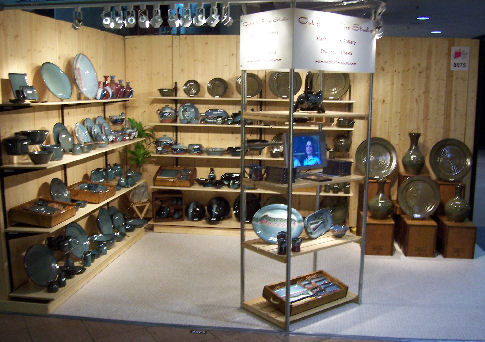


This display booth was created to answer several design requirements we noticed over the 6 plus years we attended craft, trade, and wholesale shows. The actual requirements made by show organizers vary greatly, so finding shelves or containers that work at every show is a difficult task. In order to build a booth that would allow us to meet the standards of most show organizers at shows we would realistically attend, we had to meet a set of design guidelines that encompassed them all. While the basic dimensions of a booth space might seem the same, even those may vary by three to six inches in actuality. For instance one show requires a hardwall system always, no exceptions. The booth must fit inside a ten by ten foot square and be no more than eight feet high. At another show the booth must fit inside the same space but an allowance must be made for curtains and rods already installed, so now a ten by ten booth is in reality only nine feet nine by nine feet nine. At other shows no hard walls are required at all. At the show which always requires hard walls, there is also a requirement for a three inch space at the bottom of the wall to allow access to electrical connections behind the booth. Some shows provide carpet, some do not. Some shows are dark shows, some are not. We thought about it for some time.
First a History Lesson!(Or How We Learned What NOT to Do)
Our first booth was a flimsy corrugated plastic affair(Coroplast) on 2 x 2 framing. It was very light but also very hard to keep straight and plumb. Also the plastic changed size quite a bit when moving from very cold places to warm places so it was continually warping and coming unglued. We also were still learning about colour and decided we wanted to stand out so we used a very strong green colour for the walls. Not only did this "swallow" the lighting, but some of our glazes did not show well against the green background.
Clicking on a "thumbnail" picture
will give you a larger image.
The Plan
I wanted to have a booth that would break down in to fairly small components so that it could all be loaded into a van or trailer, use only one or at the most two wrenches, and be set up by one person if the need should arise. (The ten by ten booth and product will fit in a standard size Savana van with room for driver and passenger) It must be solid and secure enough when erected that it would be totally self supporting, and capable of holding and displaying literally a half ton or more of pottery.
Finally, I wanted to use readily available, economical, materials which would complement the pottery display, not detract from it in any way, So step two was a visit to the local "big box" hardware and lumber store. Unlike using equipment leasing to display our pottery we were able to have a lot more control that would maximize the impact.
I decided to use a "post and panel" construction. The posts would directly support the shelving brackets, three per eight foot shelf, and indirectly hold up the panels made from 3/16" x 4" tongue and groove decorative strips which would give the appearance of solid walls. I looked at and discarded the idea of using eight foot 4 x 4 fence posts. I could not find any that were straight enough to begin with, and they were bound to warp over time. I settled on making posts from two 2 x 4's. Screwed together every few inches these have shown no tendency to warp and they fit in the same socket type brackets the 4 x 4's would have used with a couple of small shims.
Under the shelves I mounted kitchen cupboard type low voltage halogen "puck lights". Power for these is provided by an extension cord run across one of the side pipes and plugged in with the track lighting.
For added adjustability and stability I made up two aircraft cable lines with turnbuckles and ran one across the diagonal from the tower to the corner.
The other was mounted from the bottom of the inside corner to the top of one of the walls. Once the booth is set up , I use a bubble level on the corner posts and tower and make a few turnbuckle adjustments until everything is exactly square.
With the two support pipes from the walls to the tower mounting track lighting was a snap. I simply drilled the pipes and mounted eight feet of track under each one.
Here is one very important Electrical Safety Consideration. I also made up two extension cords with GFI (Ground Fault Interrupter) protection. Everything electrical in the display is connected to one or the other of these cords. This way should there ever be an electrical short, the power will be instantaneously disconnected and no one touching the tower will get shocked.
The side panels are hung over the pipes with garage utility hooks, strips of 1" trim support the backs of the panels above and below the center pipe, and then a single bolt with a conduit clamp is tightened to the center horizontal pipe. This removes any warped appearance and provides a final measure of stability and strength.